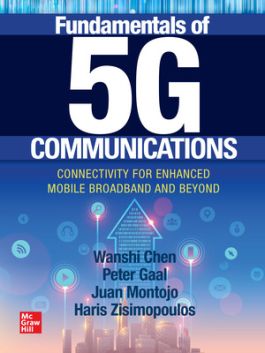Fundamentals of 5G Communications: Connectivity for Enhanced Mobile Broadband and Beyond
Receive via shipping:
- Print bound version of the complete text
Introduction
Acronyms
1 5G versus 4G: What’s New?
1.1 Overview
1.2 LTE: A Success Story
1.3 Physical Layer Changes in 5G
1.4 Protocol Changes in 5G
1.5 Main Physical Layer Features of LTE over Releases
2 Deployment Scenarios
2.1 LTE-NR Spectrum Sharing
2.2 Switched NR UL Carrier Aggregation Enhancements
2.3 Nonaligned Carrier Aggregation Operation
2.4 Frequency Ranges and Frequency Bands
3 Architecture Options for 5G
3.1 Introduction
3.2 The 5G RAN Architecture
3.3 The 5G Core
3.4 EPC versus 5GC (What Is 5GC For?)
3.5 Main Functional Entities of the 5G Core
3.6 High-Level Features of 5G Core
3.7 Network Slicing
3.8 QoS
3.9 Interworking with Non-3GPP Access Technologies
3.10 Policy Control
3.11 5G Security
3.12 Access Control and Barring
3.13 Support for Operator and Regulatory Services
3.14 Interworking with EPC
3.15 EPC to 5GC Migration
4 Evolution of 5G Architecture
4.1 Introduction
4.2 Non-Public Networks
4.3 Cellular V2X
4.4 Cellular IoT
4.5 “Big Data” Collection (Enhanced Network Automation)
4.6 Enhancements to Interworking with Non-3GPP Accesses
4.7 URLLC
4.8 Slice Authentication
4.9 Other Release 16 Features
5 Numerology and Slot Structure
5.1 Numerology and Slot Structure in 4G LTE
5.2 Lessons Learned from 4G LTE and 5G Considerations
5.3 SCSs for 5G NR
5.4 Frequency Ranges, Bandwidths, and Bands for 5G NR
5.5 gNB Channel Bandwidth versus UE Channel Bandwidth
5.6 Symbol, Slot, Subframe, and Frame for 5G NR
5.7 Slot Structure for 5G NR and Forward Compatibility Considerations
6 Initial Access and Mobility
6.1 Overview
6.2 Initial Access
6.3 Random Access
6.4 Paging
6.5 Mobility
7 Downlink Control Operation
7.1 Downlink Control in 4G LTE
7.2 Control Region Management in 5G NR
7.3 PDCCH Structure in 5G NR
7.4 Search Space for NR PDCCH
7.5 DCI Formats for NR PDCCH
7.6 Physical Layer Block Diagram for NR PDCCH
7.7 Power Saving Considerations
8 Downlink Data Operation
8.1 Channel Coding for Data
8.2 Channel Code Rate Matching
8.3 DL Soft Buffer Management
8.4 DL MCS and TBS Determination
8.5 DL Resource Allocation in the Time Domain
8.6 DL Resource Allocation in the Frequency Domain
8.7 DL Rate Matching
8.8 DL HARQ Operation
8.9 DL Data Rate Capability
8.10 Processing Time for DL Data
8.11 Demodulation Reference Signals for Data
8.12 PDSCH DM-RS
8.13 DL Phase Tracking Reference Signal
8.14 Channel State Information Reference Signal
8.15 Tracking Reference Signal
8.16 DL MIMO Scheme
8.17 CSI Feedback
8.18 Beam Management for the PDSCH
8.19 Signal Quasi Co-Location
9 Uplink Control Operation
9.1 Uplink Control in 4G LTE
9.2 UCI Types and Payload Sizes in 5G NR
9.3 PUCCH Formats in 5G NR
9.4 PUCCH Resource Determination in 5G NR
9.5 UCI on PUSCH in 5G NR
9.6 Channel Coding for UCI
10 Uplink Data Operation
10.1 UL MCS and TBS Determination
10.2 UL Resource Allocation in the Time Domain
10.3 UL Resource Allocation in the Frequency Domain
10.4 UL Rate Matching
10.5 UL HARQ Operation
10.6 UL Soft Buffer Management
10.7 UL Data Rate Capability
10.8 Processing Time for UL Data
10.9 PUSCH DM-RS
10.10 UL Phase Tracking Reference Signal
10.11 Sounding Reference Signal
10.12 UL MIMO Scheme
10.13 Beam Management for the PUSCH
10.14 UL Power Control
10.15 UL Timing
11 Coexistence of 4G and 5G
11.1 Adjacent Channel Coexistence
11.2 Same Channel Coexistence
11.3 EN-DC Power Control
11.4 Switched EN-DC UL
12 5G in Unlicensed and Shared Spectrum
12.1 Unlicensed Operation in LTE
12.2 Overview
12.3 Channel Access
12.4 Discovery Burst
12.5 Physical Layer Extensions for Uplink
12.6 Increased Scheduling Flexibility
13 Vertical Expansion: URLLC
13.1 A Brief History of 3GPP Standardization Related to URLLC
13.2 Use Cases and Deployment Scenarios for 5G NR URLLC
13.3 Resource Management for URLLC
13.4 Optimizing Link Efficiency for URLLC
13.5 Downlink Resource Sharing for Distinct Service Types
13.6 Uplink Resource Sharing for Distinct Service Types
13.7 Handling Distinct Services at the UE
13.8 Other Related Aspects
14 Vertical Expansion: MTC
14.1 A Brief History of MTC in 3GPP
14.2 Key Technical Enablers for eMTC
14.3 Key Technical Enablers for NB-IoT
14.4 Integration of eMTC and NB-IoT into 5G NR
14.5 Future Trends
15 5G Vertical Expansion: V2X
15.1 Overview
15.2 Background: LTE V2X
15.3 NR V2X
16 Vertical Expansion: Broadcast and Multicast
17 Miscellaneous Topics for 5G
17.1 Overview
17.2 Interference Management
17.3 UE Power Savings
17.4 NR Positioning
17.5 Two-Step RACH
17.6 Multi-RAT DC/CA Enhancements
17.7 Mobility Enhancements
17.8 Integrated Access and Backhaul
18 A Look at Typical 5G Commercial Deployments
19 5G: What’s Next?
19.1 Overview
19.2 Radio Projects in Release 17
19.3 Systems Projects in Release 17
19.4 NR Expansion into Higher Frequencies
19.5 Sidelink Beyond V2X
19.6 Relaying Operation
19.7 Edge Applications
19.8 On the Path to 6G
Index
Publisher's Note: Products purchased from Third Party sellers are not guaranteed by the publisher for quality, authenticity, or access to any online entitlements included with the product.
Explore the foundations and applications of 5G technology
This comprehensive guide contains practical information from telecommunications experts working at the forefront of 5G innovation. The authors discuss the foundations of 5G technology?not just the new standards, but the reasons and stories behind them. Fundamentals of 5G Communications features coverage of all major vertical domains with a focus on practical, commercial applications. This book serves both as an essential reference for telecom professionals and as a textbook for students learning about 5G.
Coverage includes:
- 5G versus 4G: What’s new?
- Deployment scenarios and architecture options
- The evolution of 5G architecture
- Numerology and slot structure
- Initial access and mobility
- Downlink control and data operation
- Uplink control and data operation
- Coexistence of 4G and 5G
- 5G in unlicensed and shared spectra
- Vertical expansion: URLLC, MTC, V2X
- Vertical expansion: broadcast and multicast
- Typical 5G commercial deployments
- A look toward the future of 5G

